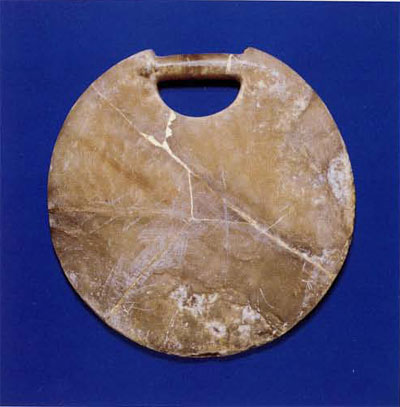
Did it once hold cosmetics for a Parthian beauty? Or perhaps weight her loom? Or maybe it was a sacred object used only for rituals. Intriguing oval slabs, or “disks,” of alabaster like this one were uncovered during expeditions to Iran in 1931 and 1933 on behalf of the University of Pennsylvania Museum. The aim of the expeditions was to search for the Parthian capital, Hecatomplyos, and shed light on the prehistoric periods of northeastern Iran through the excavation of Tepe Hissar. The three periods of the site, Hissar I, II, and III, date from approximately 4500 B.C. to 1700 B.C.
The expedition, spearheaded by Dr. Erich F. Schmidt, a German scholar, uncovered architectural remains and many burials with intriguing grave goods, including the mysterious alabaster disks. The one pictured here was found at a burial site on the “Main Mound” in what was thought to have been a warrior’s grave, based on the weaponry associated with the skeleton. Another very similar disk was part of a hoard uncovered in an area east of the Main Mound nicknamed Treasure Hill.
These slabs, indicative of the Hissar III period at the site (approximately 2000-1700 B.C.), appear suddenly at this time, along with other alabaster objects, and seem to have originated in central Asia and Baluchistan. They have been interpreted in a variety of ways.
Schmidt’s original interpretation of the items was as cult objects because, he said, “it is difficult to imagine (heir] utilitarian purpose” (“Tepe Hissar Excavations 1931,” The Museum Journal 2441, 1933:423). Dr. Holly Pittman of the University of Pennsylvania’s History of Art Department, and curator in the Museum’s Near East Section, agrees. She points out that items like these have subsequently been found in other ritual contexts to the east, like a silver vessel on which a man is represented in what appears to be a ritual scene carrying a similar object in his hand.
Comparable pieces are found at sites such as Tepe Yahya in southwestern Iran and Mehi and Gonur in central Asia. But according to Dr. Fred Hiebert of the Department of Anthropology and the Museum’s Near East Section, these items may have been a form of loom weight. Large boulders with holes pierced through the top, uncovered at Hissar and in central Asia, have been identified as weights on the basis of their domestic contexts. He thinks the alabaster slabs may have served a similar function.
Other interpretations are that they may have been palettes used in the preparation of cosmetics, or perhaps they were cutting hoards, although there is no direct evidence for these uses. Plain alabaster disks were also found at Hissar, but because they do not have grips or handles, it is unclear whether they would have served the same function.
Shannon C. White, Fowler/Van Santvoord Keeper,
Near East Section
